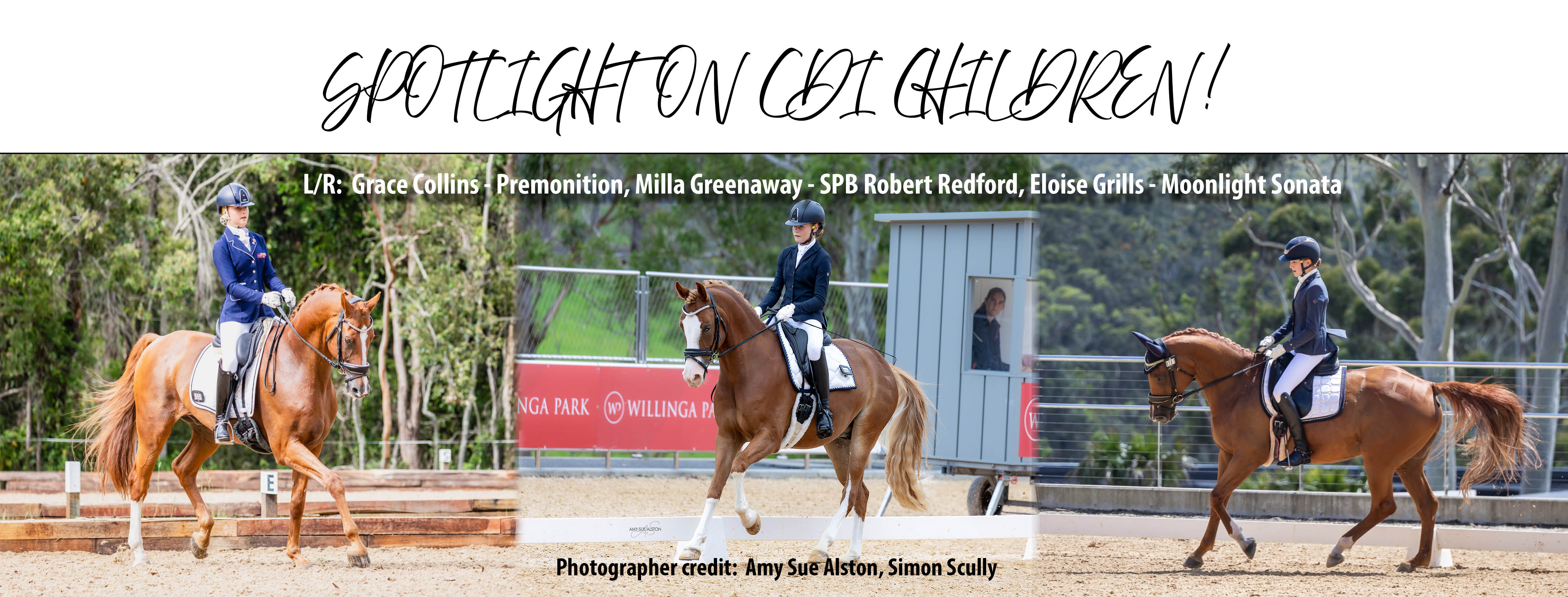How to get started in dressage
Firstly check with the Club conducting the event regarding what level of Equestrian Australia (EA) membership is required to compete at Club level in dressage competitions. The EA website has information on membership.
It is recommended that you get a copy of the EA Dressage Rules and Procedures. You can download the rule book from the web or you can order through the EA National Office. If you are riding a horse that is owned by someone else, it is advisable that the horse owner also has a copy of the Rule book.
When you are ready to start competing in Official competitions, the horse needs to be registered with Equestrian Australia (horse registration is done through the State Branches) and have a current dressage performance card. The owner of the horse and of course the rider must also be current member of EA to compete in Official competitions.
Protocol and training days
If you are feeling a bit uncertain, you could attend a training day or protocol day at your local Club. This will help you prepare for your first attempt at associate level. At protocol days, you ride a dressage test in front of an official judge (at some Clubs they may have an accredited dressage instructor in this role). After you ride the test the judge discusses the test with you and you then have a chance to ride the test again.
How to enter a competition
Choose an Event from the Dressage Calendar section of this website or from the Centreline magazine if you subscribe to it. Contact the Club and ask where you can obtain a copy of the competition schedule and an entry form. The schedules and entry form gives you all the information you need, such as the date and venue of the competition, along with the tests used in each class, entry fee, closing date for entries.
For events conducted by Dressage NSW, entries are currently made on line via Global entries. Other Clubs use Global or Nominate website for entries. Generic entry forms for use throughout NSW are also available from this site.
The test sheets are available for download from the EA web site www.equestrian.org.au
If you can’t compete early or late, or are travelling with another competitor, you need to inform the Club and most organisers try to help when allocating start times.
Remember to take your time draw with you and place it somewhere where you can easily refer to it. Plan your arrival and travel plans accordingly so you arrive at the venue allowing you plenty of time to get ready
What to wear
Some riders think they need to spend a fortune on expensive clothes and leather boots to compete in lower level dressage. This is not the case.
You need to wear:
- An approved safety headgear must be worn when training and practising at an event. Your local Saddlery will be able to help you select an approved hard hat. The types of hats you can wear depend on the level of competition. Young riders under the age of 18 must wear approved safety head gear at all times
- A short coat (usually navy or black) with shirt and tie or stock is usually worn. A hacking jacket is also fine. In hot weather the wearing of coats is optional at the discretion of the Organisers.
- White, off white, light canary or beige breeches or jodhpurs
- Riding boots, either long or short with smooth soles and heals – these can be in leather or rubber. You can wear plain gaiters with short boots as long as they match the colour of the boots which must be black or brown. The exposed side of the gaiter must be full leather.
- Spurs are allowed at all levels. Refer the rules for types of spurs allowed.
- Whips are allowed but must not exceed 1.2 metres in its entirety including the tassel for horses and 1.0 metres for ponies.
Your horse
Dressage suits all types of horses, from Pony Dressage for ponies under 149cms to the bigger horses. Horses and ponies must be over 3 years of age. To compete in “Restricted Competitions” your horse does not always have to be registered with the EA, check the current rules for details. For Official Competitions horses must be registered with the EA and have a current dressage performance card.
Gear and Saddlery
- A dressage type (including all purpose) saddle fully mounted is compulsory and can be worn with our without a saddle cloth or numnah
- A snaffle must be used in all levels up to Elementary. See .FA Dressage Rules for permitted bits
- Boots, including overreach boots, and bandages may be used for warming up, but must be removed before presenting the gear steward
- A breastplate is permitted up to medium level where a snaffle bridle is used. Foregirths and false tails are permitted at the lower levels.
- The following is not allowed: blinkers, hoods, bit guards, bearing, running or balancing reins, nasal strips.
- Bridles numbers (one of either side of the horse on the bridle or attached to the saddle cloth, is required for official competition and most Clubs require them for Restricted competitions also. To obtain a bridle number for your horse, contact Equestrian NSW.
Other gear such as running martingale (with snaffle bridle) ear muffs, saddle covers, double bridle are allowed in warm up/exercise areas but not in the competition area.
See EA Dressage Rules and Procedures for full details. Please be aware that rules change and above is a guide only, check the current rules to be sure before you start competing.
At the event
- Arrive in plenty of time. It is a good idea to check with the secretary’s office to enquire about any changes to the time draw. Most organizers will contact you to let you know about any changes however they may not be able to get in touch with you so it is worth checking. Make a note of your competitor number, which you will either be able to pick up from the Secretary’s office or you can purchase these from a Saddlery.
- Check where your class is being held, where the warm arenas and lunging areas are. Follow the code of practice for warming up in the warm up areas (see below) and remember your gloves and number.
- Keep an eye on your watch, as it is up to you to be at the arena at the right time, and remember to remove any boots and bandages before you present to the gear check steward.
- Some events have final warm-up areas and you need to check on the draw for details. At Clarendon, you are allowed into the competition area 10 minutes before your test time.
- You are welcome to ask a friend to video your performance and you can also have someone read out your test, sometimes referred to as a caller, who shouldn’t stand too close to the judge.
- You are allowed to ride around the outside of the arena for a short while before you begin your test. This is allowed when the horse before you has left the arena. Never ride too close to the arena while another horse is competing as it could upset both the horse and rider which would be unfair. The judge will sound a horn or ring a bell to tell you to start and you have up to 45secs to make your way around to A.
- If you go wrong, the judge will sound the horn. Don’t panic, as you will only lose marks for that one movement. Stop as soon as possible. If you know where you have gone wrong, raise your hand and return to the start of that movement. If you are not sure, ride towards the judge, who will tell you where you went wrong and where to restart. If you have a problem with the horse and would like to retire, let the judge know.
- Once you have put your horse away, check your marks on the scoreboard. Your test sheets can be collected about ½hr after the end of the class and it is wise to check the adding up of the scores. If they are wrong, you must point it out to the organiser immediately. If you can’t wait to collect your sheets, you can leave a stamped addressed envelope to have them sent on. Judges are often around the scoreboard after the class has finished. Do feel you can ask them questions to help you learn.
Although dressage is an extremely exacting sport, remember to enjoy the day and that everyone, even top riders, make mistakes. If you feel you would like more help, check the EA web site to locate an EA Accredited Coach near you. Our trainers want to help you improve, whatever level you ride at.
Riding in the warm up arena or practice areas
Refer the EA Dressage rule book for the etiquette for warm up arenas (Annex L - 10.2)
In order to extend courtesy to other riders and to prevent accidents, it is customary to practice the following conduct:-
- Safety is paramount and a collision should be avoided at all times.
- Before entering the warm-up area make sure the gateway and immediate track are clear
- Pass left shoulder to left shoulder when meeting another rider coming in the opposite direction.
- If you are in walk always give way to horses trotting or cantering. If you are in walk ride on the second track.
- The more progressive gait has priority on the track
- Halt should not be on the track
- Trot has priority over walk
- Canter has priority over trot
- Lateral work has priority over all paces. Make tack adjustments outside the arena if possible or near the middle of the arena but without obstructing the diagonal or centre lines.
- Announce that you intend to enter an indoor practice area to avoid an accident.
- Ensure your whip is not so long that it could upset a passing horse.
- Do not halt or walk in the outside track but always leave room for other riders to pass.It may be neccessary for you to leave the area if your horse is upsetting others
- Do not lunge in the warm-up/practice arenas without the permission of the Organiser. There are usually separated designated lunging areas on the grounds.
- Trainers or other pedestrians should not stand in the warm up or practice areas/arenas.
Riders with impaired vision may wear a white armband whilst warming up as an indication to other riders.
Stallions should be clearly identified with a green disc on the saddlecloth.



